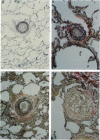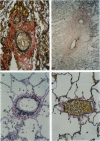Abstract
Primary pulmonary hypertension (PPH) is associated with a spectrum of structural changes in the pulmonary arteries: increased medial thickness, eccentric and concentric intimal thickening, obliteration and recanalization of arteries, and appearance of plexiform and dilatation lesions. The purpose of the present study was to further characterize these structural changes with particular emphasis on arterial adventitial thickness and alterations in the walls of the pulmonary veins. In addition, to determine whether the characteristic structural changes of PPH were size related, each was related to external diameter. With quantitative techniques, the pulmonary vasculature of 19 patients with PPH and 7 controls was examined by light microscopy. In all 19 patients, we found a striking increase in adventitial, as well as intimal and medial, thickness in arteries of all sizes when compared with controls (P < 0.05). In addition, we found intimal and adventitial thickening of pulmonary veins < 250 mu in diameter in approximately half of the PPH cases (P < 0.05). The frequency of arterial obliteration, concentric intimal thickening, and recanalization was 16, 18, and 11 of 19 cases, respectively. These changes were most prevalent in arteries less than 200 mu in diameter whereas eccentric intimal thickening and plexiform lesions occurred in 15 and 6 of the patients, respectively, and were most widespread in arteries > 200 mu. We conclude that remodeling of the pulmonary vasculature in PPH routinely includes thickening of the arterial adventitia and frequently also includes changes in the walls of the pulmonary veins. The finding that recanalization occurs predominantly in the smaller arteries whereas eccentric intimal thickening occurs mainly in the larger ones suggests that recanalization should not be considered a consequence of thromboemboli but may also occur at sites of more fibrotic intimal change.
Full text
PDF








Images in this article
Selected References
These references are in PubMed. This may not be the complete list of references from this article.
- Bjornsson J., Edwards W. D. Primary pulmonary hypertension: a histopathologic study of 80 cases. Mayo Clin Proc. 1985 Jan;60(1):16–25. doi: 10.1016/s0025-6196(12)65277-x. [DOI] [PubMed] [Google Scholar]
- Botney M. D., Bahadori L., Gold L. I. Vascular remodeling in primary pulmonary hypertension. Potential role for transforming growth factor-beta. Am J Pathol. 1994 Feb;144(2):286–295. [PMC free article] [PubMed] [Google Scholar]
- Carrington C. B., Liebow A. A. Pulmonary veno-occlusive disease. Hum Pathol. 1970 Jun;1(2):322–324. doi: 10.1016/s0046-8177(70)80045-4. [DOI] [PubMed] [Google Scholar]
- Christman B. W., McPherson C. D., Newman J. H., King G. A., Bernard G. R., Groves B. M., Loyd J. E. An imbalance between the excretion of thromboxane and prostacyclin metabolites in pulmonary hypertension. N Engl J Med. 1992 Jul 9;327(2):70–75. doi: 10.1056/NEJM199207093270202. [DOI] [PubMed] [Google Scholar]
- Dingemans K. P., Wagenvoort C. A. Pulmonary arteries and veins in experimental hypoxia. An ultrastructural study. Am J Pathol. 1978 Nov;93(2):353–368. [PMC free article] [PubMed] [Google Scholar]
- Giaid A., Yanagisawa M., Langleben D., Michel R. P., Levy R., Shennib H., Kimura S., Masaki T., Duguid W. P., Stewart D. J. Expression of endothelin-1 in the lungs of patients with pulmonary hypertension. N Engl J Med. 1993 Jun 17;328(24):1732–1739. doi: 10.1056/NEJM199306173282402. [DOI] [PubMed] [Google Scholar]
- HEATH D., EDWARDS J. E. The pathology of hypertensive pulmonary vascular disease; a description of six grades of structural changes in the pulmonary arteries with special reference to congenital cardiac septal defects. Circulation. 1958 Oct;18(4 Pt 1):533–547. doi: 10.1161/01.cir.18.4.533. [DOI] [PubMed] [Google Scholar]
- Hasleton P. S., Ironside J. W., Whittaker J. S., Kelly W., Ward C., Thompson G. S. Pulmonary veno-occlusive disease. A report of four cases. Histopathology. 1986 Sep;10(9):933–944. doi: 10.1111/j.1365-2559.1986.tb02591.x. [DOI] [PubMed] [Google Scholar]
- Hu L. M., Jones R. Injury and remodeling of pulmonary veins by high oxygen. A morphometric study. Am J Pathol. 1989 Feb;134(2):253–262. [PMC free article] [PubMed] [Google Scholar]
- Jones R., Adler C., Farber F. Lung vascular cell proliferation in hyperoxic pulmonary hypertension and on return to air: [3H]thymidine pulse-labeling of intimal, medial, and adventitial cells in microvessels and at the hilum. Am Rev Respir Dis. 1989 Nov;140(5):1471–1477. doi: 10.1164/ajrccm/140.5.1471. [DOI] [PubMed] [Google Scholar]
- Meyrick B. O., Reid L. M. Crotalaria-induced pulmonary hypertension. Uptake of 3H-thymidine by the cells of the pulmonary circulation and alveolar walls. Am J Pathol. 1982 Jan;106(1):84–94. [PMC free article] [PubMed] [Google Scholar]
- Meyrick B., Reid L. Hypoxia and incorporation of 3H-thymidine by cells of the rat pulmonary arteries and alveolar wall. Am J Pathol. 1979 Jul;96(1):51–70. [PMC free article] [PubMed] [Google Scholar]
- Meyrick B., Reid L. Hypoxia-induced structural changes in the media and adventitia of the rat hilar pulmonary artery and their regression. Am J Pathol. 1980 Jul;100(1):151–178. [PMC free article] [PubMed] [Google Scholar]
- Meyrick B., Reid L. Pulmonary hypertension. Anatomic and physiologic correlates. Clin Chest Med. 1983 May;4(2):199–217. [PubMed] [Google Scholar]
- Moser K. M., Bloor C. M. Pulmonary vascular lesions occurring in patients with chronic major vessel thromboembolic pulmonary hypertension. Chest. 1993 Mar;103(3):685–692. doi: 10.1378/chest.103.3.685. [DOI] [PubMed] [Google Scholar]
- Parks W. C., Mecham R. P., Crouch E. C., Orton E. C., Stenmark K. R. Response of lobar vessels to hypoxic pulmonary hypertension. Am Rev Respir Dis. 1989 Nov;140(5):1455–1457. doi: 10.1164/ajrccm/140.5.1455. [DOI] [PubMed] [Google Scholar]
- Pietra G. G., Edwards W. D., Kay J. M., Rich S., Kernis J., Schloo B., Ayres S. M., Bergofsky E. H., Brundage B. H., Detre K. M. Histopathology of primary pulmonary hypertension. A qualitative and quantitative study of pulmonary blood vessels from 58 patients in the National Heart, Lung, and Blood Institute, Primary Pulmonary Hypertension Registry. Circulation. 1989 Nov;80(5):1198–1206. doi: 10.1161/01.cir.80.5.1198. [DOI] [PubMed] [Google Scholar]
- Stelzner T. J., O'Brien R. F., Yanagisawa M., Sakurai T., Sato K., Webb S., Zamora M., McMurtry I. F., Fisher J. H. Increased lung endothelin-1 production in rats with idiopathic pulmonary hypertension. Am J Physiol. 1992 May;262(5 Pt 1):L614–L620. doi: 10.1152/ajplung.1992.262.5.L614. [DOI] [PubMed] [Google Scholar]
- Stewart D. J., Levy R. D., Cernacek P., Langleben D. Increased plasma endothelin-1 in pulmonary hypertension: marker or mediator of disease? Ann Intern Med. 1991 Mar 15;114(6):464–469. doi: 10.7326/0003-4819-114-6-464. [DOI] [PubMed] [Google Scholar]
- Tozzi C. A., Christiansen D. L., Poiani G. J., Riley D. J. Excess collagen in hypertensive pulmonary arteries decreases vascular distensibility. Am J Respir Crit Care Med. 1994 May;149(5):1317–1326. doi: 10.1164/ajrccm.149.5.8173773. [DOI] [PubMed] [Google Scholar]
- Wagenvoort C. A., Mulder P. G. Thrombotic lesions in primary plexogenic arteriopathy. Similar pathogenesis or complication? Chest. 1993 Mar;103(3):844–849. doi: 10.1378/chest.103.3.844. [DOI] [PubMed] [Google Scholar]




